Home Decor
Unique Features of a Mid Century Plant Stand
Achieve effortless retro charm in your home decor with mid century plant stands, boasting sleek designs, adaptable heights, and premium materials.
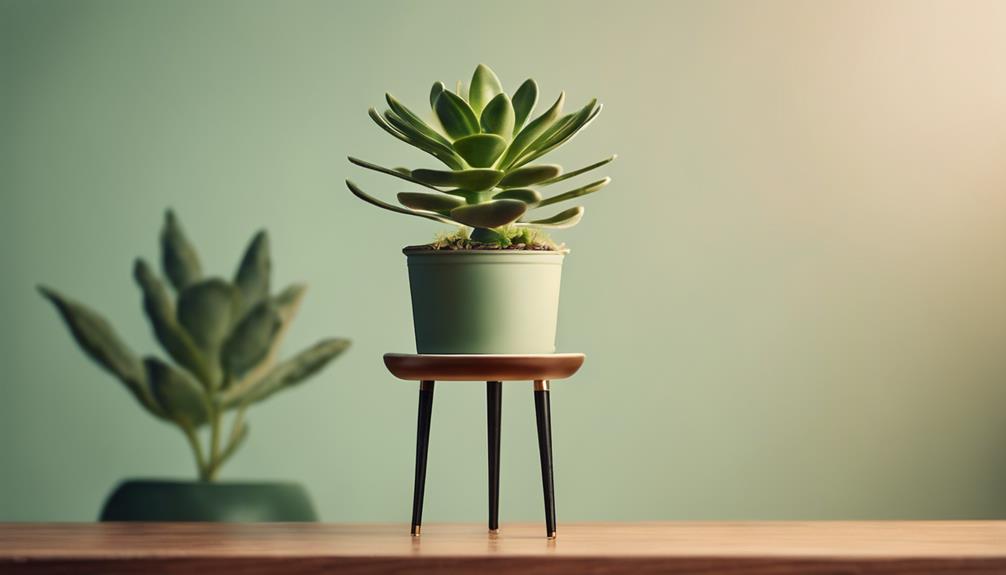
When it comes to mid century plant stands, you can expect to find a unique fusion of clean lines, geometric shapes, and minimalistic designs that not only complement various interior styles but also add a touch of retro charm to any room. These stands often feature tapered legs, sleek finishes, and natural materials like wood, metal, or bamboo. With customizable height options and adaptable designs, they can fit seamlessly into your home decor. As you explore mid century plant stands, you'll discover how they effortlessly blend modernist aesthetics with functional simplicity, and how their high-quality materials add sophistication and durability. Take a closer look to uncover the full range of their unique features.
Key Takeaways
• Mid-century plant stands feature clean lines, geometric shapes, and minimalistic designs that complement various interior styles.
• They often have tapered legs and sleek finishes, adding to their timeless appeal and sophistication.
• The use of natural materials like wood, metal, or bamboo creates a unique and authentic aesthetic.
• Customizable height options and compact space designs make mid-century plant stands adaptable to different room layouts and plant sizes.
• Attention to detail in material selection and craftsmanship ensures durability and stability for plant growth, while showcasing the plant's natural beauty.
Timeless Mid-Century Design Elements
Explore the classic characteristics that define mid-century plant stands, and you'll discover a thoughtful blend of clean lines, geometric shapes, and minimalistic designs that exude a timeless elegance. These design elements are carefully crafted to create a sense of sophistication and refinement. The use of natural materials, such as wood, metal, or bamboo, enhances the timeless aesthetic of mid-century plant stands.
The iconic tapered legs and sleek finishes are characteristic of mid-century modern furniture, including plant stands. What sets these plant stands apart is their ability to complement various interior styles, from retro to contemporary. The enduring popularity of mid-century design ensures that plant stands in this style remain a stylish and classic choice for home decor.
As you explore the world of mid-century plant stands, you'll appreciate the attention to detail and the careful consideration that goes into crafting these beautiful pieces. With their clean lines, geometric shapes, and minimalistic designs, mid-century plant stands are sure to enhance any room's décor.
Versatile Plant Stand Sizes
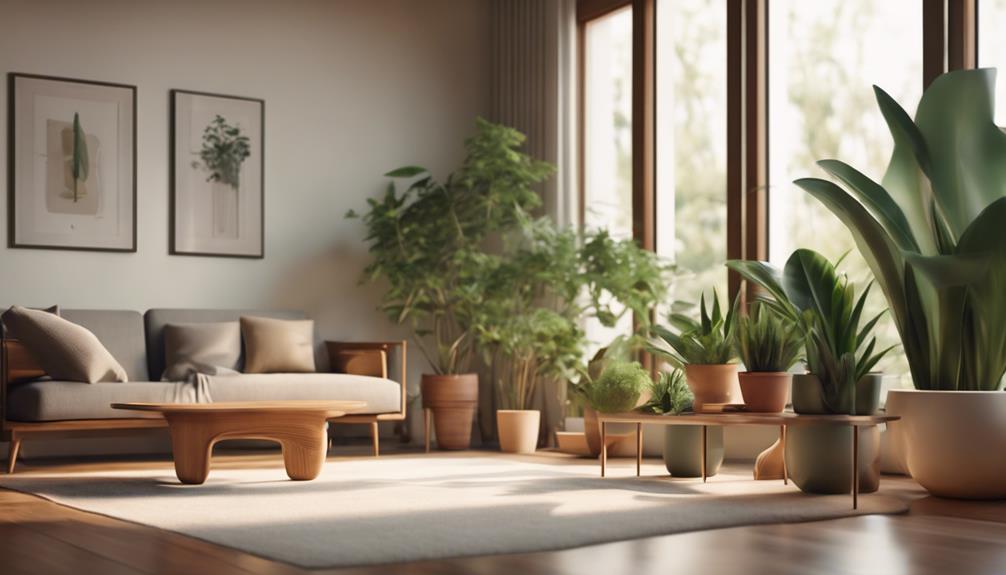
As you consider the perfect Mid Century Plant Stand for your space, you'll appreciate the versatility of our sizes, which cater to different plant types and room layouts.
With compact space options, you can easily fit a Small stand in a cozy corner or corner nook, while customizable height options guarantee your plant is showcased at its best.
Whether you're a seasoned plant enthusiast or a beginner, our stands' adaptability will help you create a stunning display that complements your unique style.
Compact Space Options
When you're working with compact spaces, mid-century plant stands offer versatile size options to fit your unique needs, ensuring your green friends thrive without overwhelming the room.
With choices like Large (24 inches) and Small (12 inches) plant stands, you can select the perfect fit for your space. The Large stand, with its 8-inch opening, is ideal for showcasing indoor trees or larger plants, while the Small stand, featuring a 6-inch opening, is perfect for succulents or smaller plants.
These stands are designed to seamlessly blend with your décor, elevating your living space and highlighting the beauty of your plants. Crafted from high-quality woods like Cherry, Walnut, and Maple, these plant stands provide stability for your plants and are built with attention to detail, embracing natural wood variations.
With options like Large stands in Cherry, Maple, and Walnut priced at $125.00, and Small stands in the same wood types priced at $65.00, you can find the perfect fit for your space and budget.
Customizable Height Options
By incorporating customizable height options, you can tailor your mid-century plant stand to perfectly showcase plants of varying sizes, effortlessly adapting to your unique space and aesthetic. This feature allows you to create a visually appealing display that complements your room's décor, without compromising on the plants' needs.
With adjustable height settings, you can cater to tall or shorter plants, providing flexibility in your home decor arrangements. For instance, the Acacia Mid-Century Plant Stand and the Bamboo Mid-Century Plant Stand both offer customizable height options, making them versatile for different plant sizes and room aesthetics.
These adjustable plant stands are designed to cater to a range of plant heights, ensuring that your green companions are displayed at their best. By choosing a plant stand with customizable height options, you can enhance the overall visual appeal of your indoor garden, creating a harmonious blend of style and functionality.
Natural Materials and Finishes
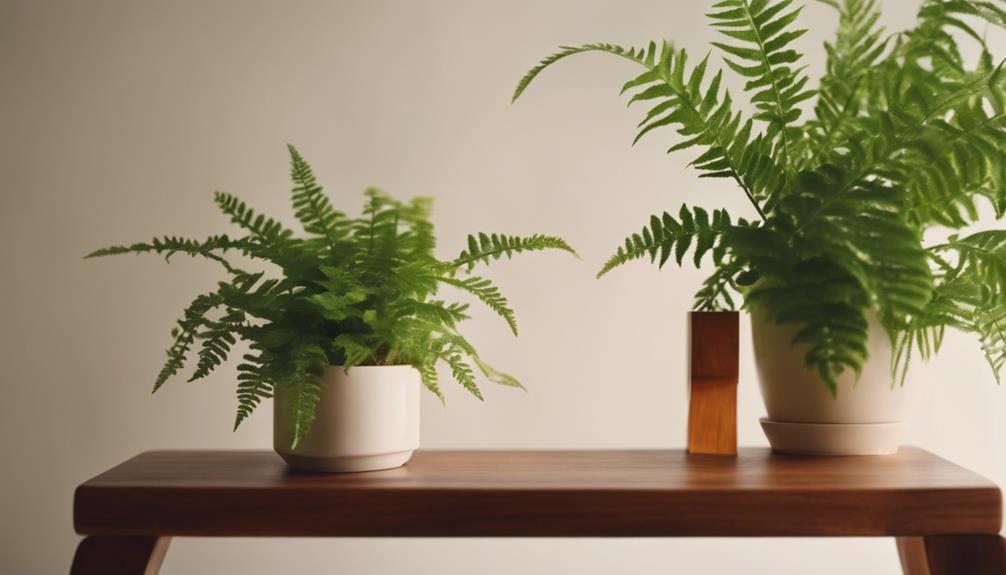
As you explore the world of mid-century plant stands, you'll notice that natural materials and finishes take center stage. From the rich tones of Cherry and Walnut to the subtle beauty of Maple, each wood type brings its unique character to the design.
Now, let's take a closer look at how wooden accents, elegant stone bases, and nature-inspired metalwork come together to create a truly exceptional piece of home decor.
Wooden Accents Shine Through
You'll appreciate how mid-century plant stands often feature wooden accents that showcase the natural beauty of materials like Cherry, Walnut, and Maple. These plant stands are crafted to highlight the unique grain patterns and finishes of the wood, adding warmth and character to any space. The use of natural materials in mid-century plant stands enhances the overall aesthetic appeal and creates a connection to nature indoors.
| Wood Type | Grain Pattern | Finish |
|---|---|---|
| Cherry | Fine, straight | Rich, reddish-brown |
| Walnut | Coarse, wavy | Dark, rich brown |
| Maple | Fine, even | Light, creamy |
The finishes on these plant stands are carefully chosen to bring out the best in the wood, whether it's a rich Cherry tone, a classic Walnut hue, or a light Maple finish. With their emphasis on natural materials and finishes, mid-century plant stands offer a timeless and elegant way to display plants while adding a touch of sophistication to your decor. As you explore the world of mid-century plant stands, you'll discover how these beautiful wooden accents can elevate your space and bring a sense of nature indoors.
Elegant Stone Bases Found
One striking feature of mid-century plant stands is the incorporation of elegant stone bases, which infuse the overall design with a sense of luxury and sophistication.
As you explore these plant stands, you'll notice that the stone bases are often crafted from materials like marble, granite, or travertine, adding a touch of elegance to the overall design. These natural materials provide a durable and stable foundation for the plant stand, ensuring longevity and sturdiness.
You can choose from various finishes, such as polished, honed, or textured, allowing you to customize the look to match your decor style. The weight of the stone base also helps to anchor the plant stand securely, preventing it from tipping or wobbling.
Nature-Inspired Metalwork
Beyond the elegant stone bases, mid-century plant stands also incorporate nature-inspired metalwork that adds a touch of organic sophistication to their design.
As you explore these plant stands, you'll notice the harmonious balance between wood and metal, blending rustic warmth with industrial chic. The metal elements, often featuring brass accents, geometric shapes, and sleek lines, bring a level of elegance to the overall design.
The finishes are carefully chosen to showcase the natural beauty of the materials, highlighting the raw textures and colors. This attention to detail creates a unique and timeless aesthetic that seamlessly blends modern design with natural elements.
Whether you're looking to add a touch of sophistication to your living room or a pop of greenery to your office, a mid-century plant stand with nature-inspired metalwork is the perfect addition.
Complementing Large Green Plants
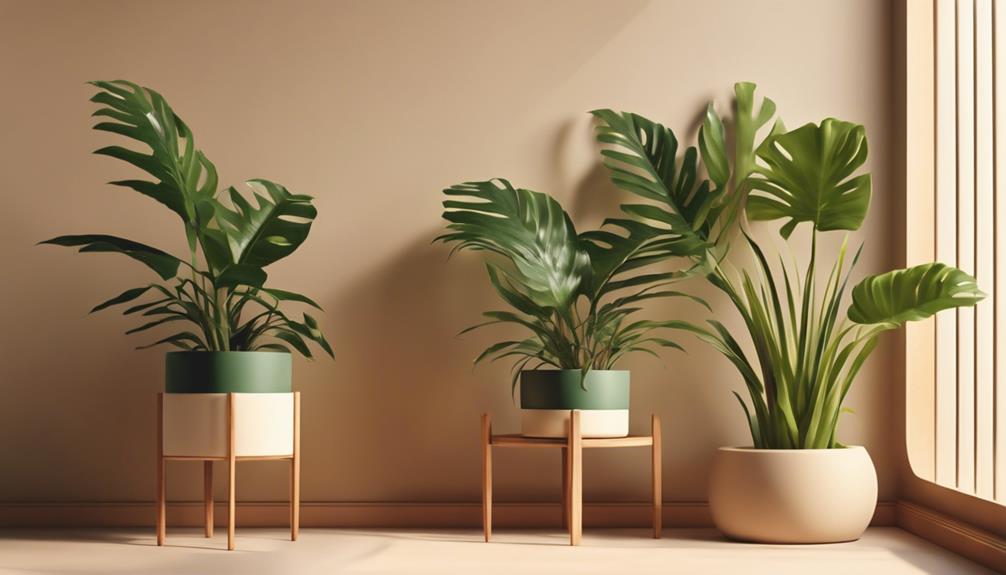
As you place a large green plant on a mid-century plant stand, the carefully crafted design enhances the beauty of the plant, creating a stunning visual display that commands attention in any room.
These stands are specifically designed to complement large green plants, amplifying the beauty and appeal of indoor spaces. Crafted from quality materials like Cherry, Walnut, and Maple wood, mid-century plant stands add a touch of elegance to the plant display.
With different sizes available, you can find the perfect stand for your indoor tree or smaller succulent. The stands provide stability and support for plant growth, making them functional and visually appealing additions to your home decor.
With attention to detail and unique natural wood variations, mid-century plant stands embrace individual charm and elevate the overall look of your green companions in any room.
Authenticity in Home Decor
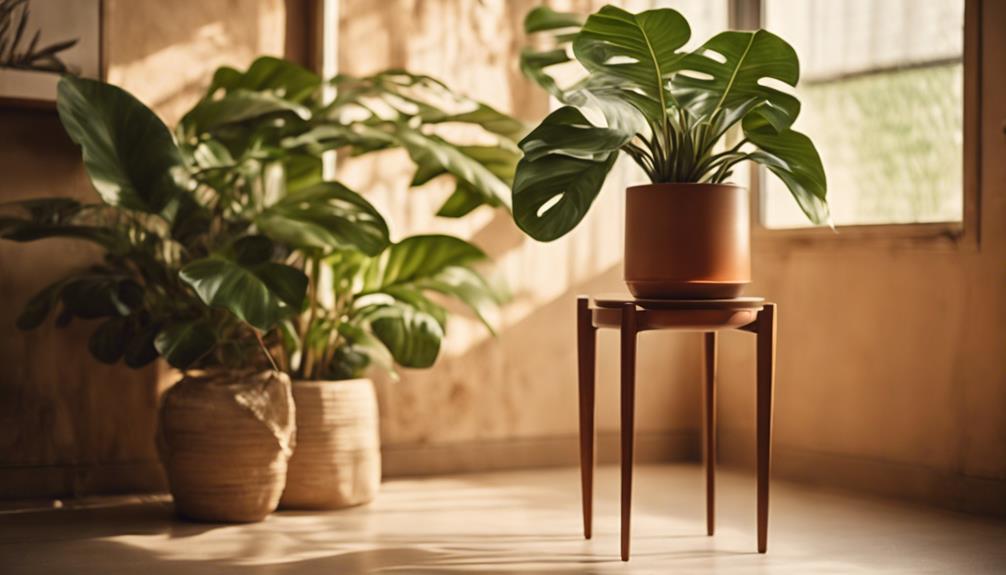
You can infuse your home decor with a sense of authenticity by incorporating mid-century plant stands that exude retro charm and timeless appeal. These unique pieces not only add a touch of nostalgia to your living space but also capture the essence of the mid-20th century design era.
Mid-century plant stands are crafted with attention to detail, ensuring stability for your plants while enhancing the overall aesthetic of the room. Their sleek lines, minimalist aesthetics, and high-quality materials, such as wood, contribute to their durability and timeless appeal.
The versatility of mid-century plant stands allows them to seamlessly blend with various decor styles, from modern to traditional. By incorporating a mid-century plant stand into your home decor, you can create a cohesive and authentic look that reflects your personal style.
With their retro charm and classic design, mid-century plant stands are an excellent way to add a touch of authenticity to your home decor.
Mid-Century Plant Stand Materials
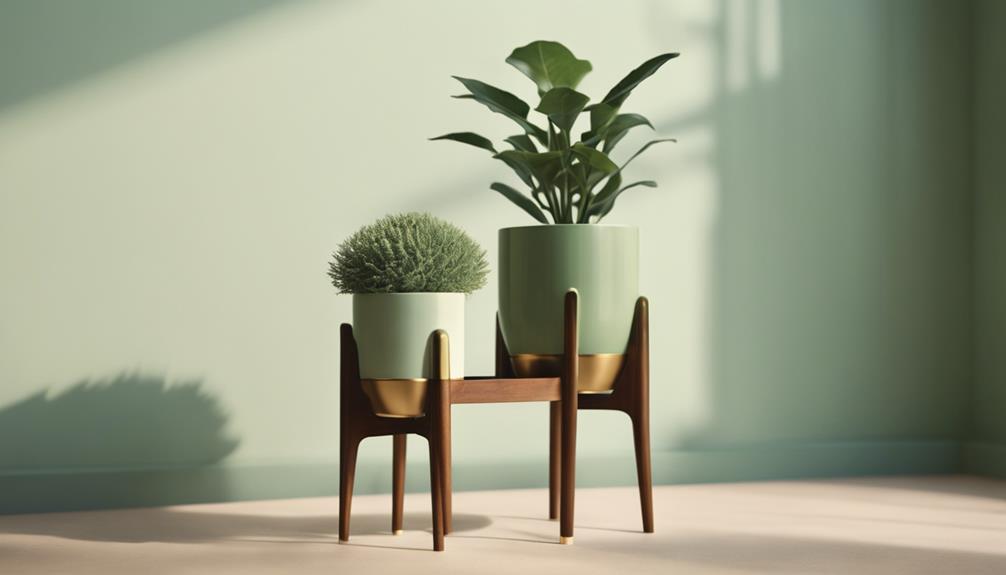
When it comes to crafting mid-century plant stands, high-quality materials like Cherry, Walnut, and Maple wood are carefully selected to guarantee both durability and aesthetic appeal.
You'll notice that these materials not only add a touch of sophistication to your living space but also secure that your mid-century plant stand remains sturdy and long-lasting.
The attention to detail in selecting these materials is what sets mid-century plant stands apart from others. The natural variations in the wood are intentionally preserved, giving each piece a unique charm that adds to its character.
As a result, you can trust that your mid-century plant stand will provide a stable base for your plants, supporting their growth and showcasing their beauty.
By choosing a mid-century plant stand, you're not only getting a functional piece of furniture but also a beautiful work of art that complements your home decor.
With the right materials, your mid-century plant stand will become a stunning focal point in any room.
Blending Modernist Aesthetics
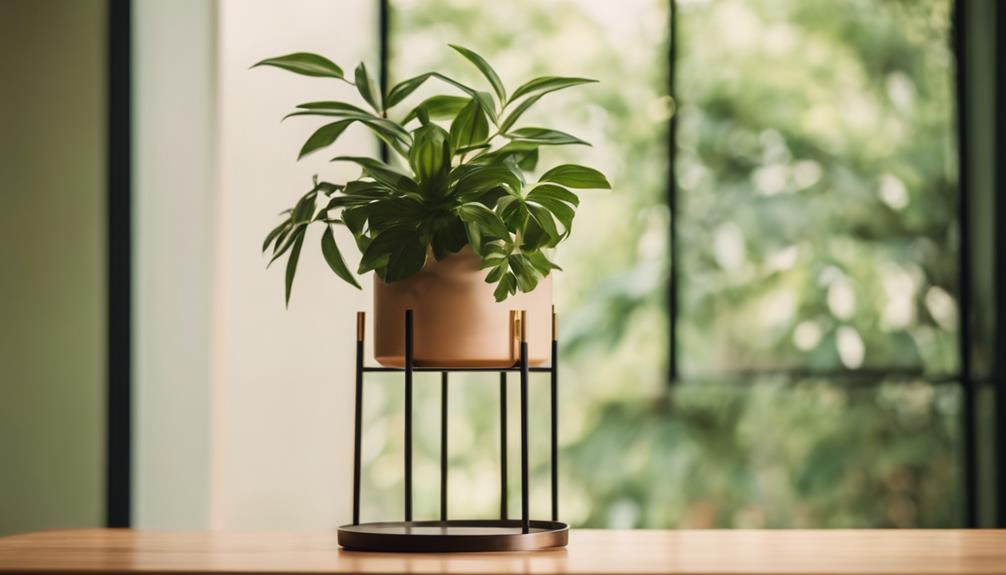
By blending modernist aesthetics with functional simplicity, mid-century plant stands effortlessly elevate the beauty of your green companions, while adding a touch of sophistication to any room.
You'll appreciate how these stands seamlessly merge clean lines, minimalist designs, and natural materials like wood, reminiscent of mid-century interior design. The result is a stylish and elevated platform for your plants to thrive.
Modern plant stands, in particular, embody this fusion of form and function, making them a perfect addition to any space. With sizes ranging from 8 to 14 inches, you can find the perfect stand to complement your plants and decor.
The use of premium materials like cherry, walnut, and maple wood adds a touch of warmth and elegance, making these stands a stylish accent to any room. By choosing a mid-century plant stand, you're not only showcasing your plants but also making a statement about your taste and appreciation for modernist design.
Elevating Home Jungle Style
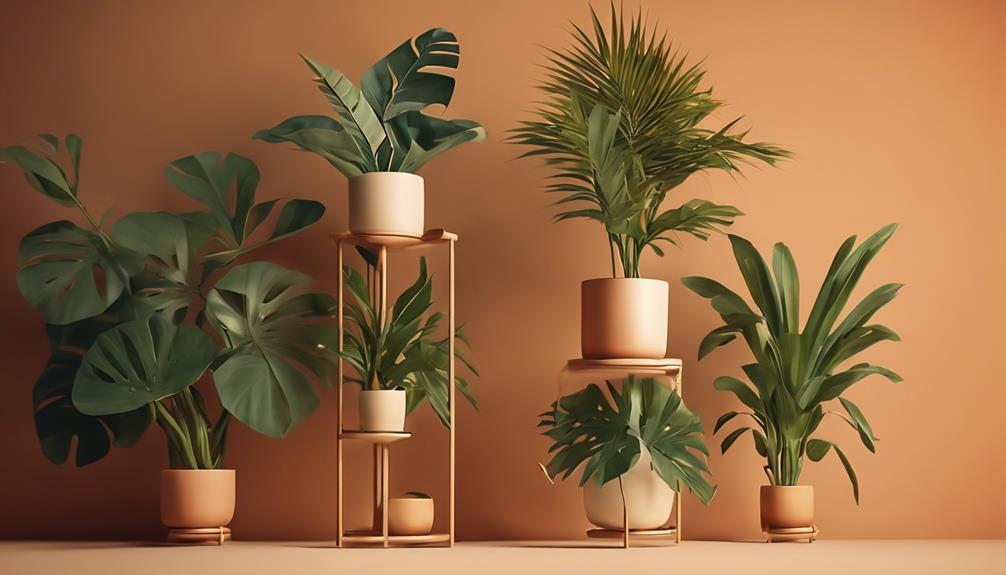
Mid-century plant stands seamlessly integrate into your home jungle, effortlessly elevating the style of your space with their classic, timeless look. You'll love how these stands blend modernist aesthetics with functional design, creating a harmonious balance between form and function.
Crafted from high-quality wood, such as Cherry, Walnut, and Maple, these stands come in Large (24 inches) and Small (12 inches) sizes to accommodate different plant needs.
Unlike modern plant stands that often prioritize style over substance, mid-century plant stands are built to last, ensuring stability and support for your plants' growth. Whether you're a seasoned plant enthusiast or a beginner, these stands are designed to complement your indoor greenery, adding a touch of sophistication to your home.
Frequently Asked Questions
What Are the Benefits of a Plant Stand?
As you consider adding a plant stand to your space, you're likely wondering what benefits it can bring.
Well, for starters, you'll be giving your plants the ideal conditions to thrive, with improved light and air circulation promoting healthy growth.
Plus, you'll be creating a stylish focal point in the room, while also saving space by stacking plants vertically.
And let's not forget the practical perk of protecting your furniture and floors from water damage!
What Else Can You Put on a Plant Stand?
You can put a lot more than just plants on a plant stand!
You can display decorative items like candles, books, vases, or small sculptures to add a personal touch to your space.
You might also use it to showcase your collection of vintage pottery or ceramic planters.
Additionally, you can repurpose it as a storage solution for blankets, towels, or magazines in your living room or bedroom.
What Is the Purpose of a Plant Holder?
When you contemplate the purpose of a plant holder, you're likely thinking about how it enhances your space.
In essence, a plant holder serves to elevate your plants off the ground, providing better visibility and access to light. This stylish display adds a touch of natural beauty to any room, complementing various decor styles.
How Do I Choose a Plant Stand?
When selecting a plant stand, you're not just choosing a pretty face – you're investing in a functional piece that complements your space and supports your plant's growth.
Consider the material, size, and design that fits your style and space. Make sure the stand provides stability and blends with your decor.
With options ranging from 12 to 24 inches in height, you're bound to find the perfect fit for your plant and home.
Conclusion
As you incorporate a mid-century plant stand into your home decor, you'll be channeling the futuristic vibes of a 1950s sci-fi film, minus the robotic butlers (unfortunately!).
With its unique blend of natural materials, versatility, and retro flair, this stylish accessory will elevate your space to a modernist oasis.
By embracing the authenticity of mid-century design, you'll be cultivating a space that's truly out of this world.
Vivienne – Your Content Companion Vivienne is your content companion, curating valuable tips, advice, and inspiration to guide you on your home decor journey. From insightful blog posts to informative product descriptions, she’s here to empower you with the knowledge you need to create your dream space.
Alfresco
What Is Alfresco Painting? Artistic Techniques Explained!
An exploration of alfresco painting, a historical technique rooted in the Renaissance, revealing artistic secrets that elevate outdoor artistry.

Explore the historical artistry of alfresco painting, stemming from the Renaissance in Italy. Artists like Giotto and Michelangelo led the way, painting on wet plaster to craft vivid frescoes. For this technique, you'll need outdoor-grade paints such as oil paints, acrylics, or watercolors, along with suitable brushes and water containers. Prepping the plaster surface meticulously is essential for a flawless finish. As you paint, remember to use soft brushes on wet plaster, allowing pigments to chemically bond with the surface for depth. Delve into this technique further to uncover the intricate details and techniques that make alfresco painting truly unique.
Key Takeaways
- Originates from Renaissance Italy, involving painting on wet plaster.
- Requires outdoor-grade paints, suitable brushes, water containers, and portable easels.
- Involves drawing directly on wet plaster and using soft brushes for blending.
- Fresh plaster crucial for strong paint bonding, vibrant colors, and longevity.
- Preservation entails curing, sealing, weather considerations, and regular maintenance.
Origins of Alfresco Painting
The origins of alfresco painting trace back to Italy during the Renaissance period, where artists pioneered the technique of painting on wet plaster to create enduring murals. This artistic practice, known as fresco, emerged as a popular method for decorating the walls and ceilings of churches, palaces, and public buildings in Italy.
During the Italian Renaissance, artists like Giotto and Michelangelo utilized fresco painting to produce magnificent works of art that showcased both their technical skill and creative vision.
Fresco painting involves applying water-based pigments on freshly laid wet plaster, allowing the colors to become an integral part of the surface as they dry. Artists would transfer their designs onto the wet plaster from a cartoon or outline drawing, enabling them to create intricate and long-lasting murals.
This technique not only provided a durable finish but also allowed for the creation of monumental and detailed artworks that adorned various architectural settings, contributing to the rich artistic legacy of the Italian Renaissance.
Materials Needed for Alfresco Painting

For alfresco painting, you'll need specific materials to create your artwork outdoors. Common materials for fresco painting include outdoor-grade paints such as oil paints, acrylics, or watercolors. These paints are chosen based on the artist's preferences and the desired effect.
In addition to paints, you'll require brushes suitable for outdoor use, water containers for mixing paints, and portable easels to support your canvas or surface.
When painting alfresco, the natural light and surroundings play a significant role in influencing the colors and atmosphere of your artwork. This medium allows artists to capture changing light, shadows, and textures in real-time, providing a unique artistic experience.
Remember that preparing the plaster surface adequately is essential before beginning your alfresco painting to maintain the longevity and quality of your artwork.
Preparing the Plaster Surface
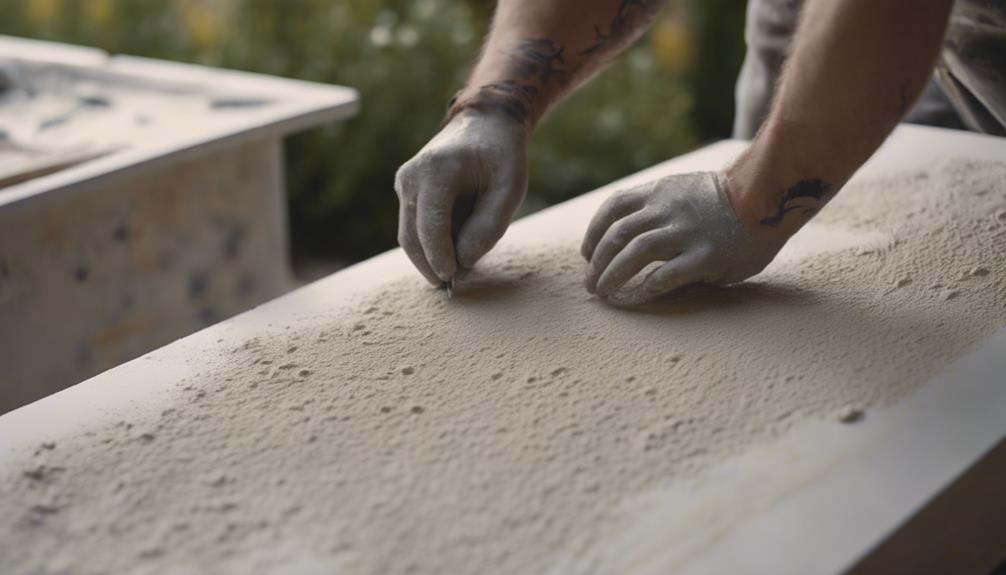
To start preparing the plaster surface for alfresco painting, ensure it's smooth and free of imperfections. This step is vital as the success of the painting relies heavily on the quality of the plaster surface.
Artists often employ traditional fresco techniques to achieve the desired smoothness and flawlessness required for alfresco painting. Ensuring the plaster surface is completely dry is essential before commencing the painting process, as any moisture can compromise the adhesion of the pigments to the surface.
Properly preparing the plaster surface not only enhances the aesthetic appeal of the final artwork but also contributes to its longevity. By meticulously attending to the details of the plaster surface, artists set a strong foundation for the application of water-based pigments, which is the hallmark of alfresco painting.
Drawing the Design on Plaster
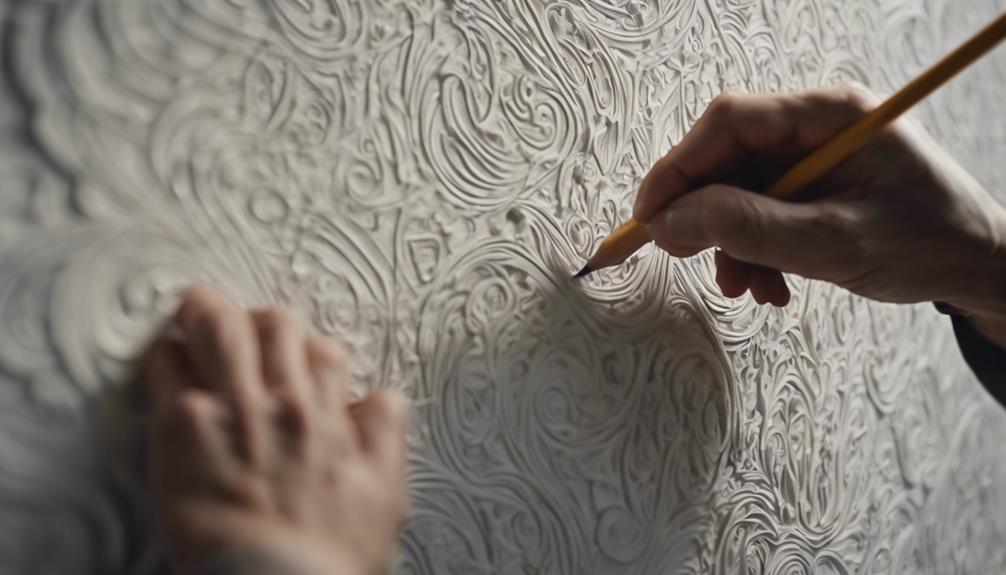
When drawing the design on plaster for alfresco painting, artists meticulously outline their vision directly onto the wet plaster surface. This technique for tracing serves as an essential guide for applying pigments and creating the mural.
Ensuring accuracy and cohesion in the final artwork, this step allows for the seamless integration of the design into the larger mural composition.
Plaster Design Preparation
Efficiently transferring the desired artwork onto the fresh plaster surface is a crucial step in the process of preparing the design for an alfresco painting. Artists utilize tools like brushes, pencils, or styluses to outline the design directly onto the prepared plaster surface.
These design outlines act as a roadmap for the artist, guiding them through the painting process in the alfresco technique. Precision and accuracy in this step are essential as they greatly impact the overall composition of the artwork.
Drawing the design on plaster marks the critical initial phase in creating vibrant and enduring alfresco paintings. By carefully tracing the design onto the plaster, artists lay the foundation for a visually captivating mural that withstands the test of time.
This meticulous process ensures that the artwork isn't only visually appealing but also structurally sound, enhancing its longevity and artistic impact.
Technique for Tracing
Using a sinopia sketch or cartoon, artists meticulously trace the design onto the fresh plaster surface to prepare for the alfresco painting process. Tracing is an essential step in fresco painting, as it allows artists to transfer the intricate details of their design onto the plaster with precision and accuracy.
By following the lines of the sketch or cartoon, artists can guarantee that the final composition reflects their original vision faithfully. This technique not only guides the artist during the painting process but also aids in the placement of elements within the composition. Through tracing, artists can achieve a level of detail and accuracy that would be challenging to attain freehand.
Ultimately, tracing plays a significant role in ensuring that the final fresco painting is a true representation of the intended design, capturing every nuance and detail with meticulous care.
Painting Techniques in Alfresco Painting
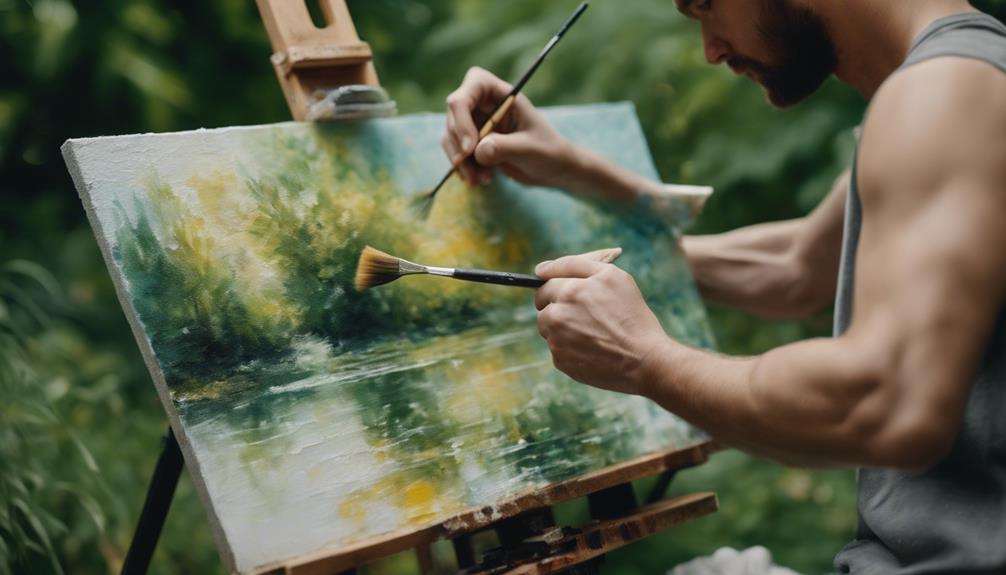
To achieve intricate details and vibrant colors in alfresco painting, artists employ specific brushwork techniques on the freshly applied plaster. Working on wet plaster allows the pigments to bond chemically with the surface, ensuring the artwork becomes a permanent part of the wall in mural painting.
The technique involves using soft brushes to apply pigments to the wet surface, with the colors becoming brighter as the plaster dries. Artists must work swiftly and confidently to capture the desired hues and textures before the plaster sets. By blending and layering pigments on the wet surface, they can achieve depth and dimension in the mural.
This method of painting on wet plaster gives the artwork a matte finish and durability that's ideal for large-scale murals. The process of painting on wet plaster requires skill and precision to create lasting and visually stunning pieces of art.
Importance of Fresh Plaster in Painting
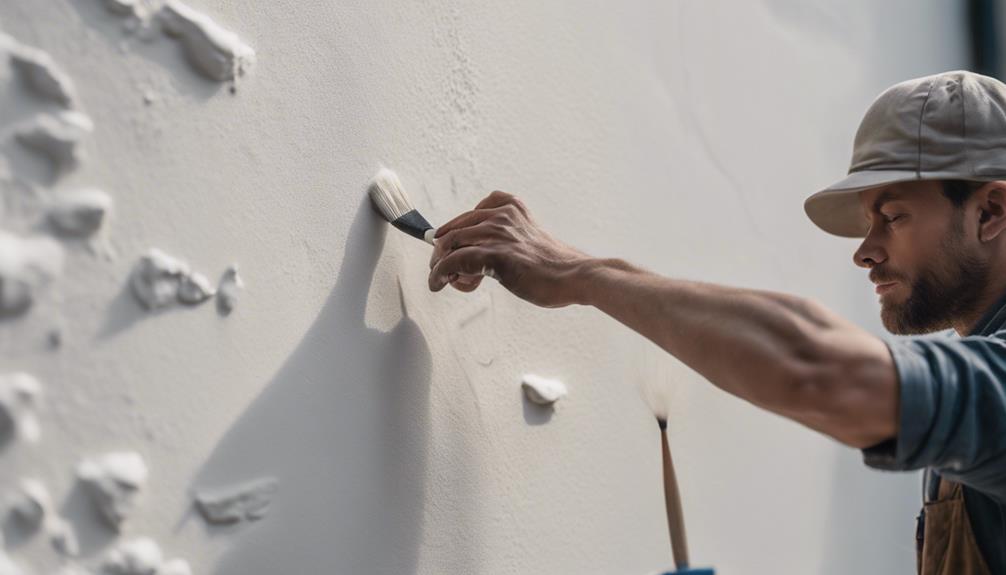
Fresh plaster plays a vital role in alfresco painting by ensuring that the paint adheres securely to the wall surface, enhancing its durability over time.
The porous nature of fresh plaster allows the pigments to be absorbed, creating a strong bond between the paint and the wall.
Artists find that painting on fresh plaster provides a smooth and receptive canvas for their artistic expression, resulting in vibrant and long-lasting colors on the wall.
Fresh Plaster Enhances
Enhancing the vibrancy and longevity of painted colors, fresh plaster plays an essential role in alfresco painting techniques. When working with fresco painting, fresh plaster acts as a pivotal foundation that allows the colors to bond effectively, creating lasting artwork. The porous nature of fresh plaster enhances the vibrancy of the colors, ensuring they remain vivid over time. Additionally, painting on fresh plaster provides artists with a smooth and even surface to work on, allowing for intricate details and precise brushwork.
To further illustrate the importance of fresh plaster in alfresco painting, consider the following table:
| Benefits of Fresh Plaster in Alfresco Painting |
|---|
| Allows colors to bond effectively |
| Enhances color vibrancy and longevity |
| Provides a smooth surface for detailed work |
Painting Adhesion and Durability
For ideal adhesion and durability in alfresco painting, fresh plaster plays a critical role in bonding water-based pigments to the wall surface. In fresco painting, the application of fresh plaster serves as the foundation for the paint to guarantee effective bonding, ensuring a long-lasting finish.
The interaction between the fresh plaster and water-based pigments is essential for creating a strong bond that withstands the test of time. Without the use of fresh plaster, the paint may not properly set on the wall surface, leading to potential issues such as flaking or peeling over time.
Fresh plaster in alfresco painting isn't just a surface preparation step but a fundamental component in enhancing the vibrancy and longevity of the colors applied. It allows for a seamless integration of the paint into the wall, becoming a permanent part of the structure.
The meticulous attention to using fresh plaster guarantees a durable and visually striking outcome in fresco painting.
Curing and Sealing the Fresco
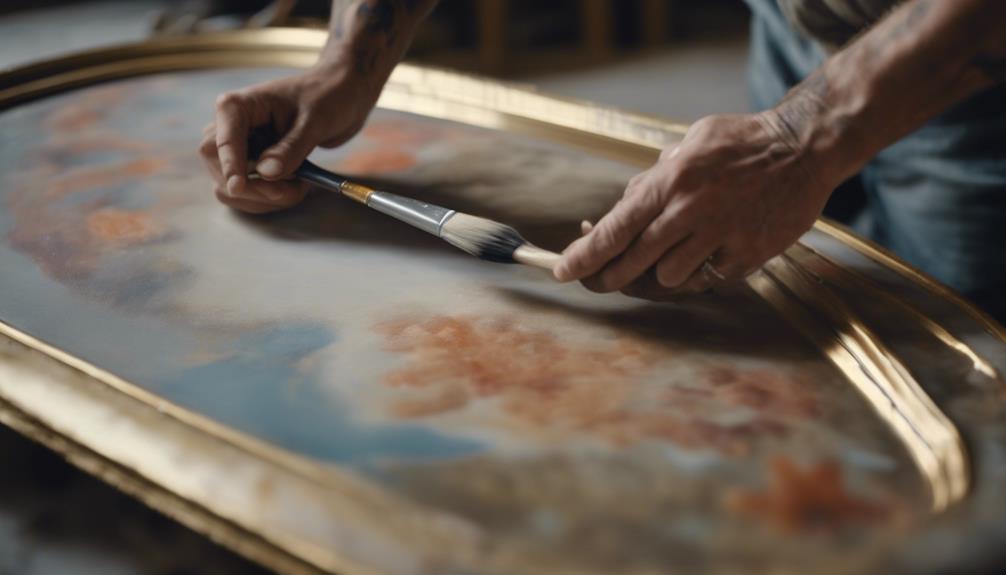
Curing and sealing the fresco is an essential final step in guaranteeing its longevity and preservation. The curing process involves allowing the fresco to dry naturally over several weeks. This period is vital for achieving full strength and durability as the pigments chemically bond with the plaster. Properly curing the fresco guarantees a lasting and vibrant artwork.
Sealing the fresco with a protective coating, such as a transparent glaze or wax, further enhances its longevity. This protective layer helps shield the fresco from environmental factors like dust, dirt, and moisture, preserving its colors and details for years to come. By properly curing and sealing the fresco, you aren't only maintaining its integrity but also ensuring its beauty withstands the test of time.
This meticulous process is fundamental for the long-term preservation of fresco paintings, making them a valuable and enduring art form.
Tips for Successful Alfresco Painting
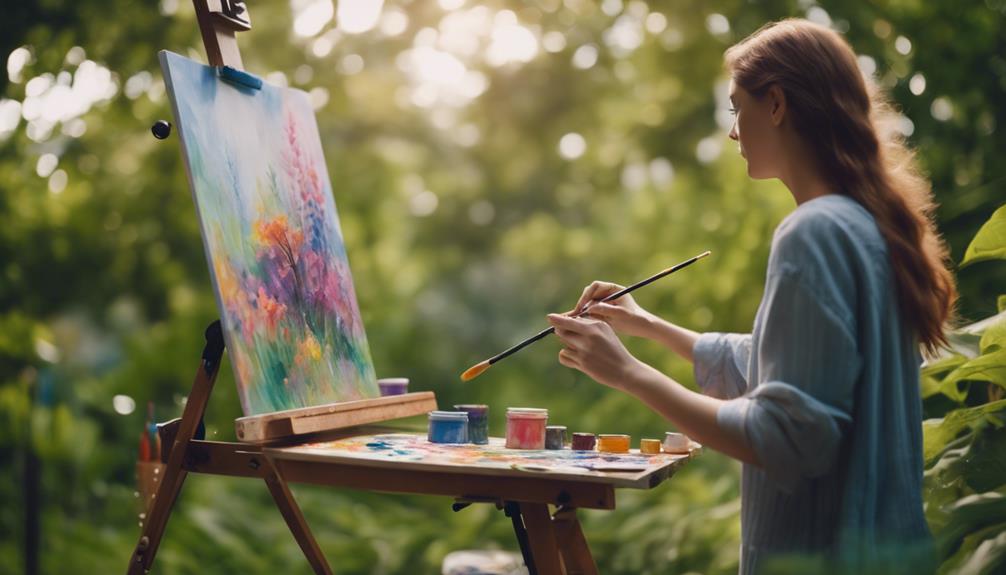
When starting alfresco painting, keep in mind that the choice of location can greatly impact your artwork's outcome.
Considering the weather conditions is essential for a successful painting session outdoors.
Location Choice Matters
Selecting the right location is key to ensuring successful alfresco painting, as it greatly impacts the outcome of your artwork. When choosing a spot for your outdoor painting session, consider factors such as lighting, scenery, and ambiance. Here are some tips to help you make an informed decision:
| Consideration | Description | Example |
|---|---|---|
| Lighting | Opt for locations with natural light sources to enhance colors and shadows. | Painting near a lake during sunset. |
| Scenery | Choose settings that inspire your creativity and complement your artistic vision. | A lush garden with vibrant flowers. |
| Ambiance | Look for places that provide a peaceful and inspiring atmosphere to focus on your art. | A quiet meadow with the sound of birds chirping. |
Weather Considerations Crucial
Considering weather conditions is crucial for successful alfresco painting. It directly impacts the quality and process of your artwork.
Temperature plays a significant role in determining the drying times of your paints. Extreme heat can cause them to dry too quickly, affecting the blending and overall finish of your piece. On the other hand, cold temperatures can prolong drying times, leading to potential smudging or smearing if not carefully monitored.
Additionally, humidity levels in the air can influence how your paints adhere to the canvas, impacting the richness and depth of colors achieved. It's advisable to work during times when the temperature is moderate, avoiding peak sunlight hours that can accelerate drying excessively.
Inspirational Examples of Alfresco Art
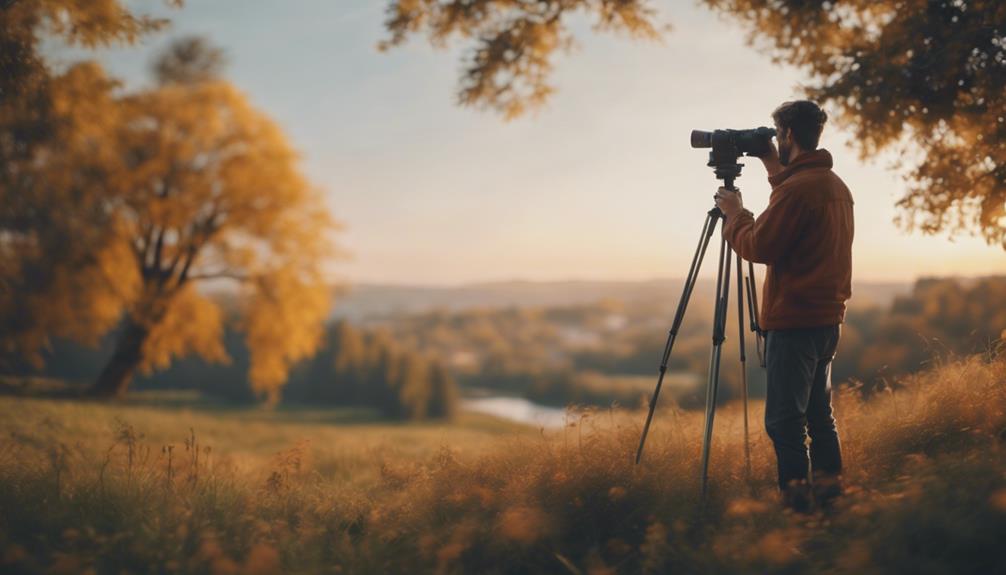
Explore a variety of awe-inspiring alfresco artworks that showcase the beauty and creativity of painting outdoors. Alfresco painting, with its roots in capturing the essence of nature, has produced some remarkable pieces throughout history.
One of the most iconic examples of alfresco art is Michelangelo's masterpiece in the Sistine Chapel. The intricate frescoes adorning the chapel's ceiling are a testament to the skill and dedication required for this painting technique.
Artists like Monet and Sargent also found inspiration in painting outdoors, using plein air techniques to convey the changing light and atmosphere in their works.
These influential artists paved the way for contemporary alfresco painters, who continue to create stunning pieces that blur the lines between art and nature. From vibrant landscapes to intimate portraits, alfresco art offers a unique perspective that can only be achieved by working directly from the natural world.
Preservation and Maintenance of Alfresco Paintings
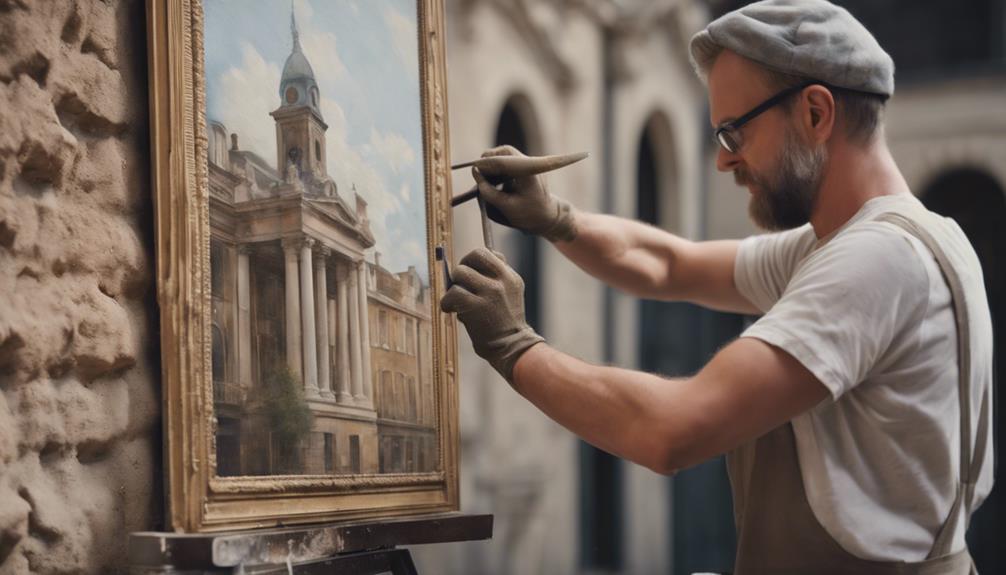
To guarantee the longevity and beauty of alfresco paintings, preservation and maintenance are crucial steps in protecting these artworks from environmental damage. Preservation of fresco paintings involves safeguarding them from weather elements such as rain, sun exposure, and temperature fluctuations.
It's essential to maintain these pieces by regularly cleaning them to remove dirt, grime, and pollutants that could harm the artwork over time. Applying protective coatings or sealants can help extend the lifespan of alfresco paintings and prevent color fading.
In cases where restoration is necessary, conservators may repair cracks, reattach loose paint, and address any structural issues to ensure the durability of the artwork. Professional conservators utilize specialized methods and materials to safeguard fresco paintings, ensuring that their beauty and historical significance are preserved for future generations to appreciate.
Frequently Asked Questions
What Is the Fresco Painting Technique?
The fresco painting technique involves applying water-based pigments on freshly applied plaster, creating durable murals. Artists grind dry-powder pigments in water to create colors that dry and set with the plaster, allowing for detailed artworks.
What Does Al Fresco Mean in Painting?
Imagine painting under the open sky, capturing nature's essence with each brushstroke. 'Al fresco' in painting means embracing the outdoors. Artists use this term to signify creating art in the fresh air, connecting with nature's beauty.
How Does an Artist Create a True Fresco Painting?
To create a true fresco painting, you meticulously apply water-based pigments on fresh plaster while transferring your design. Each day, you paint sections on wet plaster, ensuring colors become permanent as they dry within the surface.
Why Is Fresco Painting Significant?
Fresco painting is significant due to its durability and ability to create monumental murals. Artists like Michelangelo favored it during the Italian Renaissance. Applying water-based pigments on wet plaster makes colors permanent, allowing detailed work.
Conclusion
To sum up, alfresco painting is a timeless art form that requires skill, patience, and attention to detail.
As you commence on your own alfresco painting journey, remember that like a fresco, life is a canvas waiting to be painted with vibrant colors and intricate designs.
So, take inspiration from the masters of the past, embrace the process of creating something beautiful, and let your creativity shine through in every brushstroke.
Happy painting!
Home Decor
Set the Perfect Mood in Any Room With These Lighting Tips – You’Ll Be Amazed!
Unlock the secrets to transforming your space with simple lighting tips that will leave you amazed at the results!
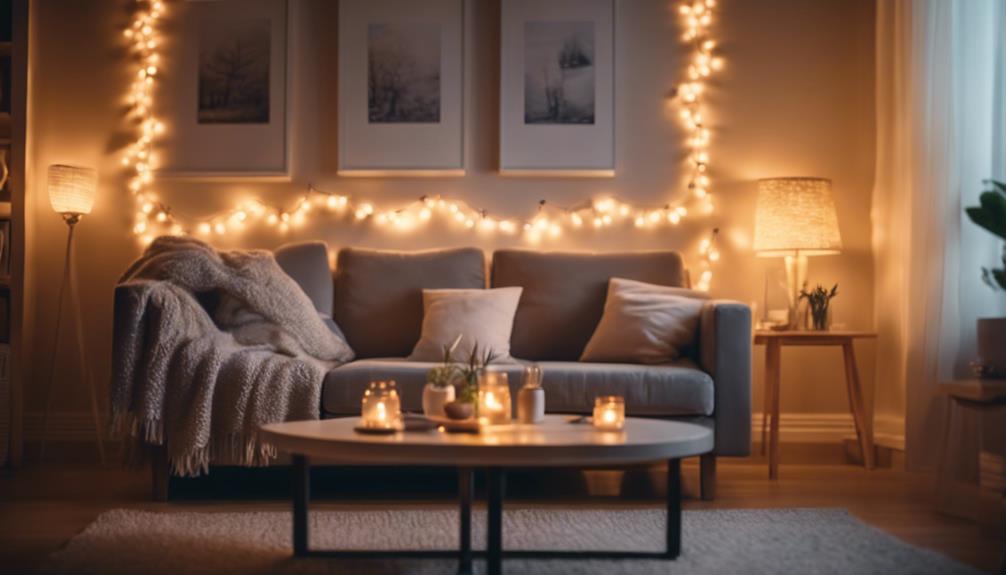
You can easily set the perfect mood in any room with just a few lighting tips. Start by using a mix of ambient and task lighting to create comfort and functionality. Dimming your lights softens the atmosphere for intimate gatherings, while warm-toned bulbs foster positivity. Layer your lighting with floor lamps, sconces, and colored LED bulbs to add depth and visual interest. Consider natural elements, like salt lamps, to enhance relaxation. These simple adjustments can transform your space. For even more ways to elevate your home's vibe, you'll want to explore additional creative lighting techniques!
Key Takeaways
- Use dimmable fixtures or candles to easily adjust ambiance for gatherings or relaxation, creating a warm and inviting atmosphere.
- Layer lighting with multiple sources, such as floor lamps and wall sconces, to enhance room aesthetics and depth.
- Choose warm-toned bulbs to create a flattering environment that boosts confidence and enhances emotional connections.
- Incorporate task lighting in functional areas to ensure safety and productivity while maintaining a cozy atmosphere.
Understanding Mood Lighting
Understanding mood lighting is essential because it can dramatically shape your emotions and experiences in any space. The right mood lighting creates an inviting atmosphere that enhances your feelings and interactions.
Ambient lighting, particularly when it has a warm glow, is vital for setting the tone. It not only softens harsh realities but also boosts confidence, especially in romantic settings.
Research shows that many people prefer dimmed lighting during intimate moments, often due to worries about body visibility and self-image. By using warm tones, you can create a more flattering environment that reduces self-consciousness and heightens enjoyment. This positive lighting can make a significant difference in how you and your partner connect, fostering deeper emotional ties.
Incorporating multiple light sources and adjusting colors can further enhance your space. You're not just illuminating a room; you're curating an experience that promotes well-being and satisfaction.
Types of Lighting to Consider
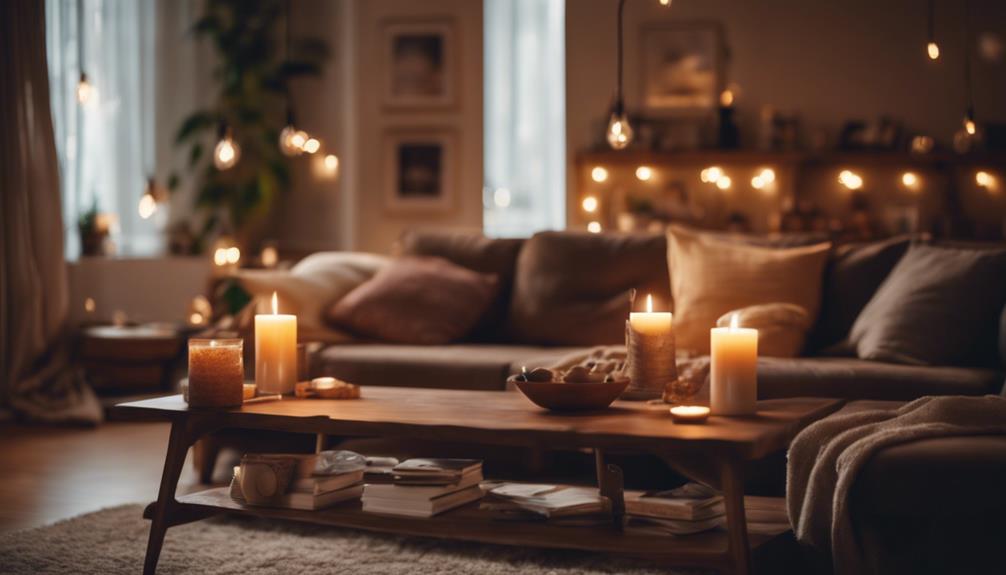
To create the perfect atmosphere in your space, it's important to explore the different types of lighting available, each serving a unique purpose in enhancing your home's ambiance.
Start with ambient lighting, which sets the overall tone and mood of a room. Options like floor lamps and recessed lights provide a soft glow that enhances comfort and relaxation, making your space feel inviting.
Next, consider task lighting. This type is essential for functional areas where you need focused illumination. Under-cabinet lights in kitchens or desk lamps in home offices guarantee you can perform specific activities efficiently and safely. Task lighting not only aids productivity but also prevents eye strain.
Techniques for Effective Atmosphere
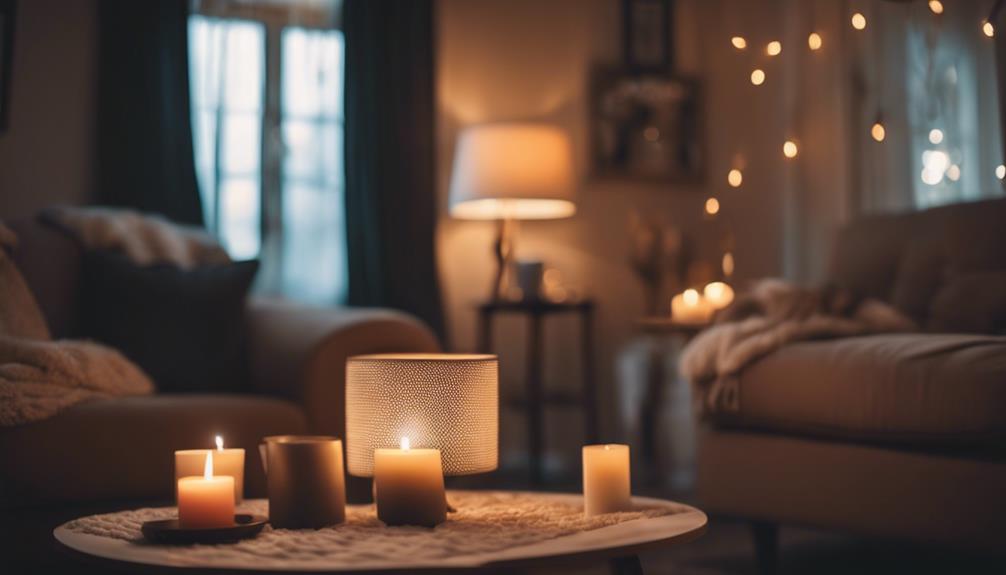
Creating the right atmosphere in your space involves a strategic blend of lighting techniques that cater to your specific needs and preferences.
Start by using dimmable light fixtures or candles to soften the ambiance, perfect for gatherings or relaxation. Multiple light sources, like floor lamps, wall sconces, and table lamps, allow you to adjust the mood effortlessly while enhancing the overall aesthetic of your room.
Consider incorporating smart home technology, which lets you customize brightness and color to suit different occasions. This adaptability guarantees your space feels just right, whether you're hosting friends or enjoying a quiet evening alone.
Opt for warm-toned lighting to boost self-confidence and create an inviting environment, fostering positive interactions. For a calming atmosphere, try adding natural elements like Himalayan salt lamps; they not only provide a gentle glow but also contribute to a soothing vibe.
Creating Intimacy With Light
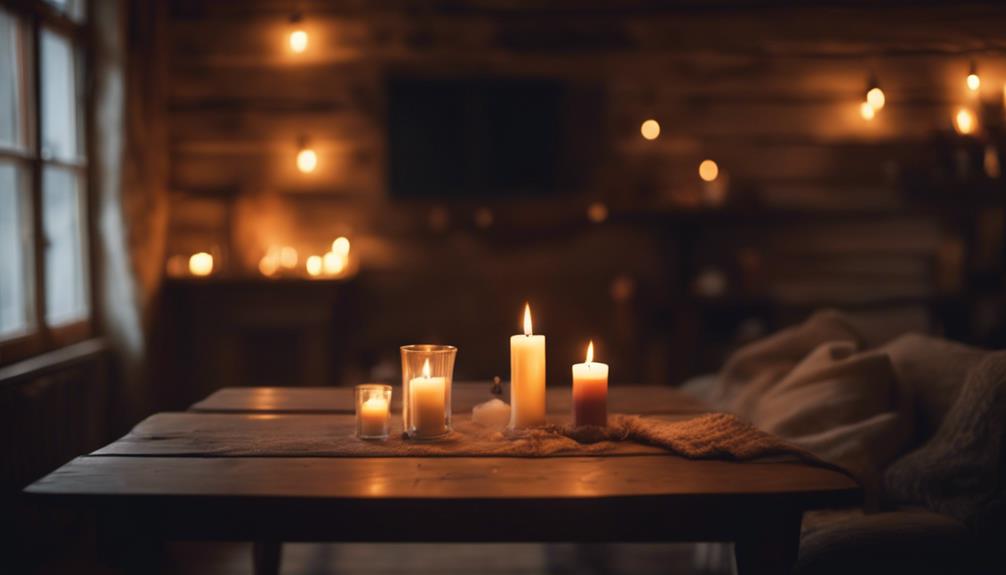
Soft lighting sets the mood for intimacy, helping you and your partner feel more relaxed and connected. When you dim the lights, the atmosphere transforms, inviting a sense of closeness. A warm, amber glow creates a cozy environment that encourages emotional bonding.
According to a Harris Poll, 62% of people prefer intimate moments with the lights off, emphasizing the power of reduced visibility in fostering comfort.
Incorporating ambient lighting solutions like Himalayan salt lamps or colored bulbs can greatly enhance the mood of a space. These options not only cast a soft light but also add a unique charm that can elevate your romantic experiences.
Warm tones in lighting improve appearance and boost self-confidence, allowing both you and your partner to feel at ease during those special moments.
Practical Lighting Tips for Rooms
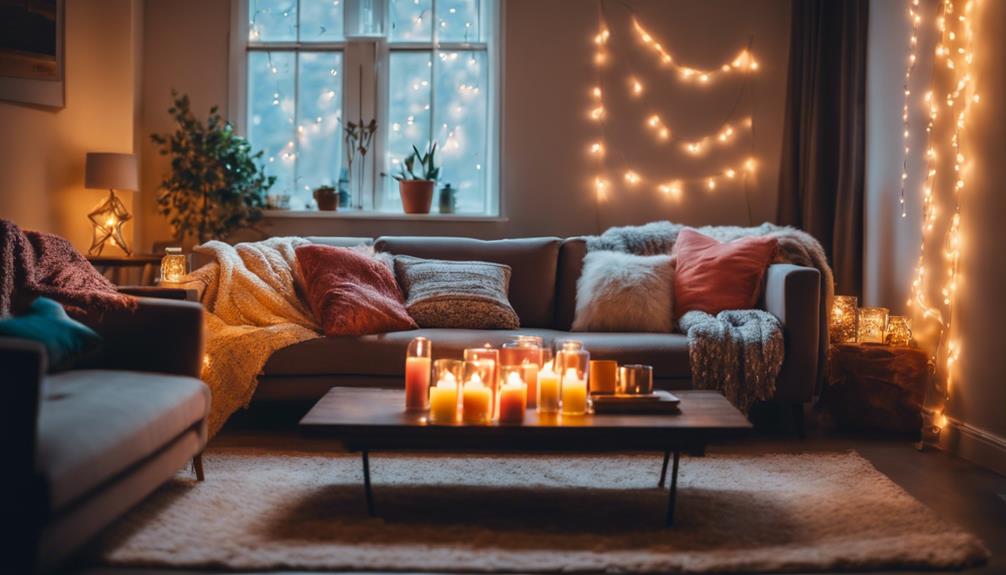
Maximizing the effectiveness of your lighting can transform any room into a more inviting and functional space. Start by incorporating dimmer switches to easily adjust the lighting intensity, allowing you to create the right ambience for relaxation or social gatherings.
Layer your lighting with multiple sources, like floor lamps, table lamps, and recessed fixtures, to add depth and visual interest.
In spaces like living rooms and bedrooms, opt for warm-toned bulbs. They enhance appearance and boost confidence, making your environment feel more welcoming.
For functional areas like kitchens, utilize task lighting by combining overhead fixtures with under-cabinet lights. This guarantees ideal usability and safety while you cook.
Don't forget to experiment with strip lighting! It's perfect for accentuating architectural features or creating a cozy atmosphere in various spaces.
Consider using color-changing LED bulbs as well; they allow you to customize the atmosphere according to your mood or occasion. By mixing different shades and intensities throughout your rooms, you'll achieve a well-lit space that feels just right for any activity.
Frequently Asked Questions
How to Set the Mood With Lighting?
To set the mood with lighting, use warm-toned bulbs and multiple light sources. Incorporate soft lighting for comfort, and experiment with unique options like Himalayan salt lamps to create a playful, intimate atmosphere.
What LED Light Puts You in a Good Mood?
Imagine warm, soft oranges and yellows wrapping around you like a cozy blanket. Those LED lights lift your spirits, while playful purples spark joy, and calm blues keep you alert. Choose your mood, light it up!
How Does Room Lighting Affect Mood?
Room lighting affects your mood considerably. Warm tones can boost your confidence and create a relaxing atmosphere, while bright lights keep you alert. Adjusting lighting alters your feelings, enhancing intimacy and emotional satisfaction during interactions.
How Does Lighting Affect the Mood of a Scene?
You might think lighting doesn't matter much, but it profoundly shapes a scene's mood. Soft, warm tones create intimacy, while harsher lights can evoke tension. Carefully chosen lighting enhances emotions, fostering connections and making moments memorable.
Conclusion
Now that you've got the tools to set the perfect mood, imagine this: you're hosting a cozy dinner party.
Soft, warm lights flicker from strategically placed lamps, while candles on the table cast a gentle glow.
Friends laugh and share stories, feeling instantly relaxed in the inviting atmosphere you've created.
With these lighting tips, you can transform any space, making every gathering memorable and every moment special.
So go ahead, let your creativity shine!
Home Decor
Ways to Incorporate Handmade Crafts Into Your Country Home Decor
Find inspiration in unique handmade crafts that will transform your country home decor into a cozy haven—discover the endless possibilities!
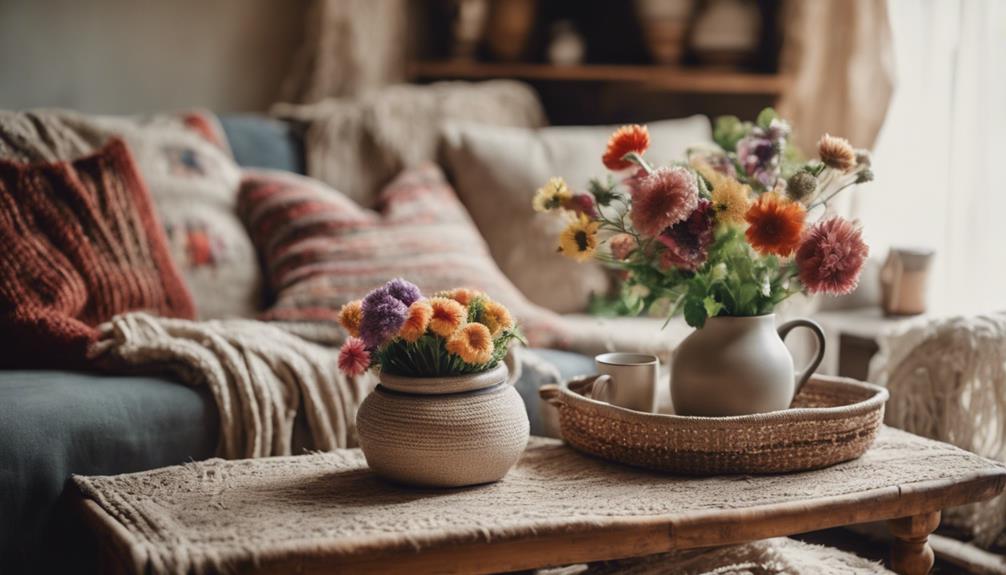
Incorporating handmade crafts into your country home decor adds a personal touch that enhances its cozy, rustic vibe. Start with thrifted items like wooden trays or vintage dishes to infuse character. Use natural elements, such as grapevine or jute ribbons, to layer textures. Adorn your dining table with burlap runners and mason jar centerpieces full of seasonal flowers. For lighting, try handcrafted pendant lights or rustic lanterns draped with twinkling fairy lights. Don't forget the walls; personalize with hand-painted frames or quilted fabric wall art for extra charm. Keep exploring to discover even more creative ideas!
Key Elements
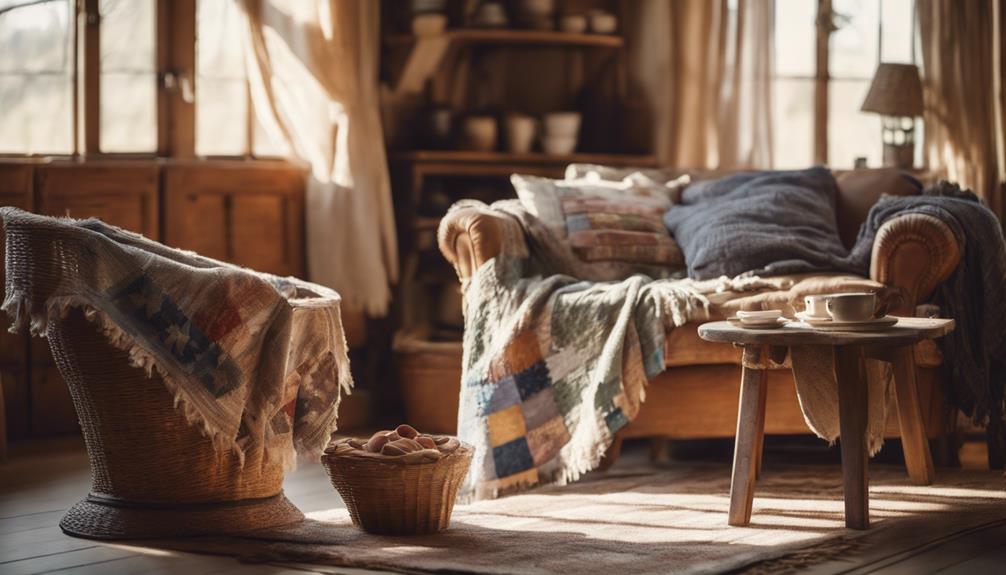
When it comes to crafting for your country home, the right color scheme, materials, and textures can make all the difference.
You'll want to choose warm, earthy tones that reflect the natural beauty of the countryside.
Incorporating these elements will help create a cohesive and inviting atmosphere in your decor.
Color Scheme
How can you achieve a warm and inviting color scheme in your country home decor?
Start by embracing earthy tones like cashew and moss chalk paint. These colors can breathe new life into thrifted items, giving them a rustic touch that fits perfectly in a country setting.
Make sure to incorporate vintage-inspired colors such as yellow maze and night sky to create visual interest and depth in your handmade crafts.
To balance your decor, select floral arrangements featuring a mix of colors. Elements like blueberries, white flowers, and greenery should complement each other harmoniously, enhancing the overall aesthetic.
You can also implement natural elements and textures, like jute ribbon and grapevine, to add warmth and character while sticking to a cohesive color palette.
Materials
To create a truly authentic country home decor, select materials that reflect the rustic charm and warmth of your space. Start by incorporating thrifted items like wooden caddies, tin buckets, and vintage dishes. These unique finds add character and charm, making your decor feel lived-in and inviting.
Utilize natural elements, such as grapevine and faux greenery, to enhance your arrangements. These materials help create a cohesive, rustic aesthetic that emphasizes the beauty of nature.
Don't forget to add a personal touch with handmade tags made from coffee-stained manila paper. Use hand lettering and distressing techniques to elevate your decor further.
Experiment with floral arrangements, incorporating elements like blueberries and white flowers for whimsical accents. Remember to maintain visual balance by using odd numbers in groupings, which naturally draws the eye.
Finally, consider employing creative finishing techniques on thrifted wood items. A dry brushing of chalk paint or a touch of antique wax can give these pieces a vintage appearance, seamlessly blending them into your country decor.
Textures
Incorporating a variety of textures, like the roughness of distressed wood and the softness of jute, creates a warm and inviting atmosphere in your country home decor. You can easily find thrifted items that embody that rustic charm, enhancing the overall depth of your space. Natural elements, such as grapevine and faux greenery, not only add tactile appeal but also help unify your aesthetic.
To introduce softness, consider using jute ribbon or bows made from gingham or denim. These elements not only complement the country style but also add layers of interest. Mixing smooth surfaces, like painted jars, with the rough textures of sanded wood allows for striking contrasts in your decor.
Don't forget to layer materials for added richness. Think coffee-stained manila tags paired with antique wax finishes to achieve a vintage look that enhances your home's texture. By thoughtfully selecting and combining these various textures, you'll create an inviting space that reflects your personality and love for handmade crafts.
Embrace the beauty of these elements, and watch as your country home decor transforms into a cozy haven.
Essential Fixtures and Furniture
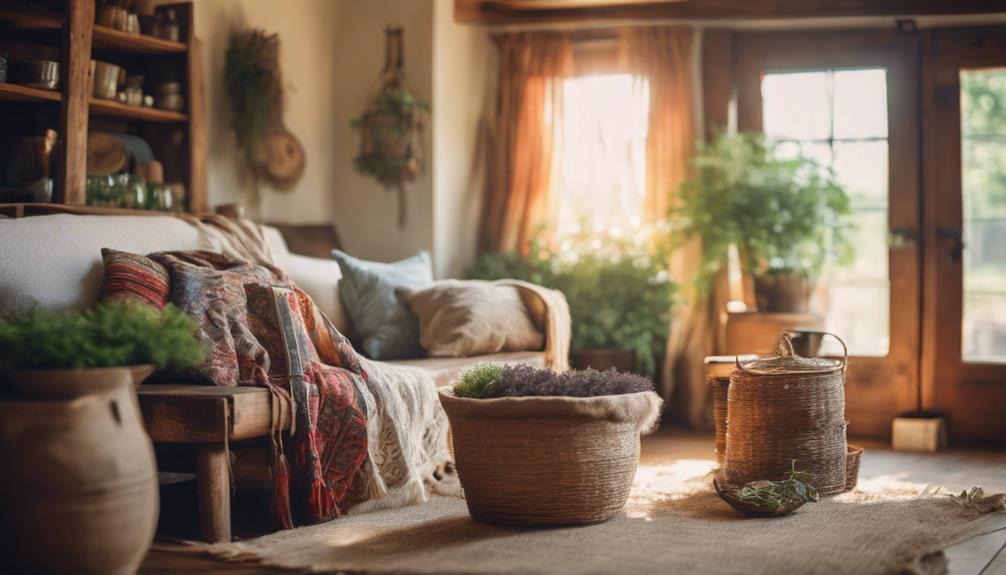
When you think about essential fixtures and furniture for your country home, consider how a rustic wooden dining table can serve as the heart of your space.
An antique mason jar chandelier adds a unique touch, illuminating your gatherings with charm.
Don't forget woven basket wall hangings; they not only provide storage but also enhance the cozy, handcrafted vibe you're aiming for.
Rustic Wooden Dining Table
A rustic wooden dining table acts as the heart of country home decor, showcasing unique wood grains and imperfections that enhance its charm. This central piece invites family and friends to gather, infusing warmth and character into your space.
To personalize your table, incorporate handmade crafts like hand-carved wooden serving trays or custom burlap table runners. These additions not only complement the rustic aesthetic but also reflect your unique style.
Surrounding your dining table with antique or vintage chairs can create a cohesive look, which you can often find at thrift stores or flea markets. This combination reinforces the country theme and adds layers of history to your dining experience.
For an extra touch, decorate with mason jars filled with wildflowers or hand-painted wooden centerpieces. These elements elevate your table's visual appeal while maintaining a rustic feel.
Antique Mason Jar Chandelier
An antique mason jar chandelier not only illuminates your space but also enhances the rustic charm established by your wooden dining table. It serves as a stunning centerpiece, blending functional lighting with delightful vintage aesthetics. To create your chandelier, source vintage mason jars from thrift stores or flea markets; these can be repurposed as shades for light bulbs, casting a warm, inviting glow.
Mixing different sizes and styles of mason jars adds visual interest and unique character to your chandelier design. Consider using jute or hemp rope to hang the jars, which enhances the natural, rustic aesthetic that complements your country home decor beautifully. This approach not only keeps the look cohesive but also adds a touch of earthy texture.
For a personalized touch, you can embellish the jars with hand-painted designs or distressed finishes, reflecting your individual style and creativity. Crafting this chandelier becomes a rewarding project that showcases your handmade spirit while providing essential lighting.
Woven Basket Wall Hanging
Woven basket wall hangings add both charm and functionality to your country home decor, creating a striking focal point while providing storage solutions. These handcrafted pieces bring texture and warmth, enhancing the rustic feel of your space. By incorporating different sizes and shapes of woven baskets, you can create visual interest and depth on your walls.
To make the most of your woven baskets, consider layering them against a backdrop of farmhouse-style shiplap or muted paint colors. This contrast highlights their natural materials and craftsmanship beautifully. For an extra personal touch, combine the baskets with handmade tags or embellishments, like jute ribbon, to achieve a cohesive and charming aesthetic.
Don't forget to integrate faux greenery or florals within the baskets to introduce a splash of nature and color. This simple addition transforms your wall hanging into a dynamic element that breathes life into your decor.
Lighting Ideas
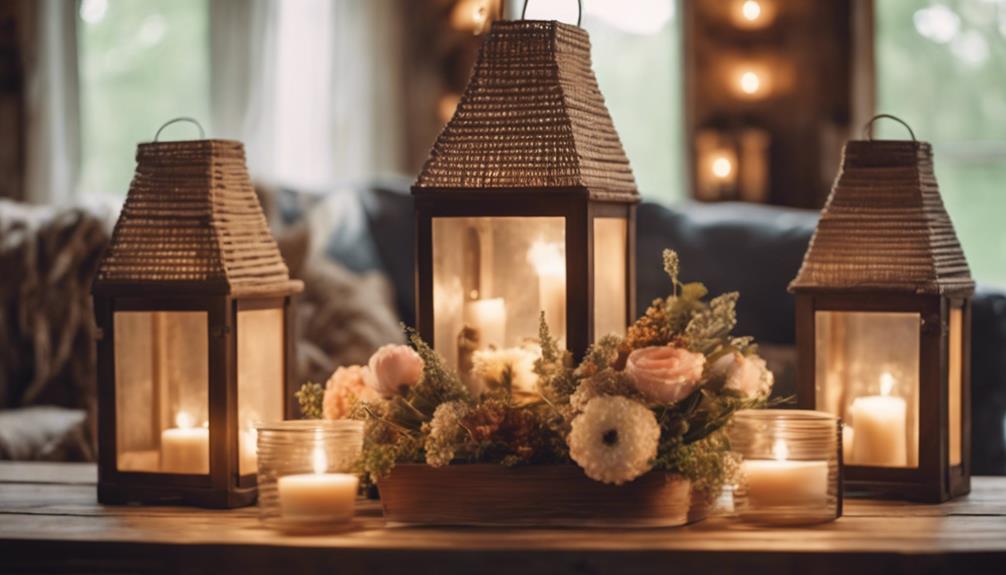
When it comes to lighting your country home, you've got plenty of creative options to contemplate.
Rustic lantern string lights can set a cozy mood, while a vintage table lamp trio adds character to your space.
Don't forget about handcrafted ceramic pendant lights and rustic iron wall sconces, which can beautifully enhance your decor.
Rustic Lantern String Lights
Rustic lantern string lights add a warm, inviting glow to your country home decor, transforming any space into a cozy retreat. You can create these charming lights by repurposing thrifted lanterns, often found at second-hand stores for as low as $1.99. Simply fill them with fairy lights to achieve that perfect ambiance.
If you don't have lanterns, mason jars work just as well. Painting them with chalk paint gives them a distressed look, and adding LED string lights inside will enhance their appeal.
To further embrace the rustic aesthetic, wrap twine or jute ribbon around your lanterns or jars. This small detail ties your decor back to the country theme. Hang your handmade lantern string lights along porches, patios, or even inside your living spaces to create a cozy atmosphere, ideal for gatherings or quiet evenings.
Don't hesitate to experiment with different heights and arrangements. Cluster lanterns or jars together on a table or shelf, mixing them with floral arrangements for added visual interest.
With these simple touches, your country home will radiate warmth and charm, making it an inviting space for everyone.
Vintage Table Lamp Trio
Adding a vintage table lamp trio to your decor not only enhances the lighting but also brings a unique charm that complements your handmade crafts. Sourcing these lamps from thrift stores or flea markets can lead you to one-of-a-kind designs that encapsulate the essence of country decor.
Consider mixing styles, such as ceramic, metal, and glass, to create a visually interesting arrangement that adds depth to your lighting scheme.
To refresh old lamp bases, use cashew chalk paint or other soft hues that blend seamlessly with your rustic aesthetic. This simple update keeps the vintage feel while ensuring the lamps fit your overall decor.
You can further enhance their appeal by adding decorative elements like jute ribbon or distressed tags to the shades, tying them in with other handmade items in your home.
Position your trio strategically, whether on side tables or mantels, to create warm, inviting light. This setup not only illuminates your space but also highlights the beauty of your handmade crafts, making your country home feel cozy and welcoming.
With these lamps, you'll see how lighting can be both functional and a stylish statement.
Handcrafted Ceramic Pendant Lights
Handcrafted ceramic pendant lights bring a unique charm to your country home decor, showcasing artisanal craftsmanship through their distinct glazes and textures. These lights not only illuminate your space but also serve as stunning decorative pieces that reflect your personal style. You can choose from a variety of shapes and sizes, allowing for a customized look that complements your existing decor while adding a personal touch.
The natural materials used in these pendant lights, such as clay, resonate beautifully with the rustic aesthetic of country homes. They create a warm and inviting atmosphere, perfect for cozy gatherings with family and friends. To enhance your lighting's functionality and sustainability, consider incorporating energy-efficient LED bulbs, which work seamlessly with ceramic designs.
Position your ceramic pendant lights over key areas like kitchen islands or dining tables. This practical placement not only provides essential illumination but also establishes a focal point that elevates your overall design.
With their artisanal qualities and versatility, handcrafted ceramic pendant lights can transform any space, making them an essential addition to your country home decor.
Rustic Iron Wall Sconces
Iron wall sconces offer a perfect way to enhance your country home decor, providing ambient lighting while adding a vintage touch that complements your handcrafted ceramic pendant lights. These rustic sconces often come with intricate designs and a sturdy construction, making them ideal for showcasing your handmade crafts, like mason jar candle holders or floral arrangements.
When selecting wall sconces, consider pieces with a distressed finish, as they harmonize beautifully with other rustic elements, such as reclaimed wood furniture and vintage decor. You can also pair your sconces with natural materials like jute or burlap to add an inviting texture that emphasizes the handmade aesthetic.
Utilizing wall sconces to display seasonal decor, such as small wreaths or greenery, allows you to create a versatile styling option that can change with the seasons. This flexibility adds a dynamic element to your decor while maintaining a cohesive look throughout your home.
Incorporating rustic iron wall sconces not only illuminates your space but also serves as a stylish backdrop for showcasing your cherished handmade crafts, enhancing the overall charm of your country home.
Decorative Elements
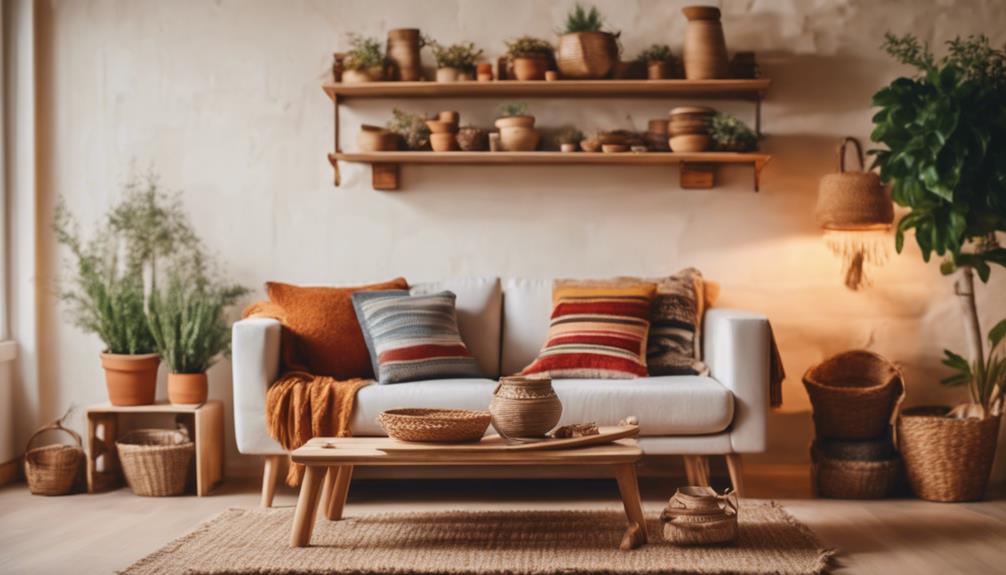
When it comes to decorative elements, hand-painted wooden picture frames can add a personal touch to your walls.
You'll love the warmth of quilted fabric wall art, which brings a cozy, inviting feel to any room.
A rustic clay pot centerpiece can tie everything together, offering an earthy charm that perfectly complements your country home decor.
Hand-Painted Wooden Picture Frames
Customizing hand-painted wooden picture frames with chalk paint or acrylics adds a personal touch that beautifully complements your country home decor style. You can choose colors that match your existing palette or add a pop of vibrancy to your space. To achieve a rustic, vintage appearance, consider using distressing techniques like sanding and applying antique wax. This approach not only enhances the frame's character but also fits seamlessly into a country-themed aesthetic.
To further elevate your frames, you might add decorative elements such as jute ribbon, faux greenery, or small floral accents. These details can tie the frames into your overall decor theme and create a cohesive look throughout your home. For an extra layer of personalization, think about using manila tags with hand lettering or coffee staining. These charming labels can give each frame a unique story.
When arranging multiple frames on a wall, try incorporating a triangle pattern. This technique establishes visual balance and enhances the overall look of your decor, making your hand-painted frames a stunning focal point in your country home.
Quilted Fabric Wall Art
Handmade quilted fabric wall art beautifully complements hand-painted picture frames, adding warmth and texture that enhances the rustic charm of your country home decor. You can choose from various fabric patterns and colors to create a cohesive aesthetic that reflects your personal style. Incorporating patchwork designs not only evokes nostalgia but also connects to heritage, making these pieces meaningful focal points in your living spaces.
Using natural fibers like cotton or linen for your quilted wall art enhances its rustic appeal while ensuring durability and easy care. You can display quilted pieces in several ways, whether framed or hung as standalone art. This versatility allows you to mix and match with other decorative elements in your home.
To make your quilted fabric wall art truly unique, consider adding embellishments such as buttons, lace, or embroidery. These personal touches will express your creativity and elevate your decor. Overall, quilted fabric wall art serves as an inviting and beautiful addition to your country home, making it feel warm, welcoming, and full of character.
Rustic Clay Pot Centerpiece
A rustic clay pot makes a stunning centerpiece that effortlessly showcases seasonal floral arrangements and natural elements, enhancing the charm of your country home decor. You can fill the pot with a delightful mix of faux berries, white flowers, and greenery to create a lively, whimsical look that reflects nature's beauty.
To add visual interest, arrange your flowers using a triangle pattern, ensuring balance and symmetry within the display. This approach draws the eye and makes the centerpiece more appealing. For an extra touch of texture, consider wrapping jute ribbon or gingham fabric around the rim of the clay pot, perfectly complementing the rustic aesthetic.
Don't forget to personalize your centerpiece! Attaching handmade tags with hand-lettered messages can evoke a warm, inviting atmosphere, making your guests feel right at home. You might also incorporate natural elements like grapevine or faux greenery for a cohesive look that ties everything together.
Flooring
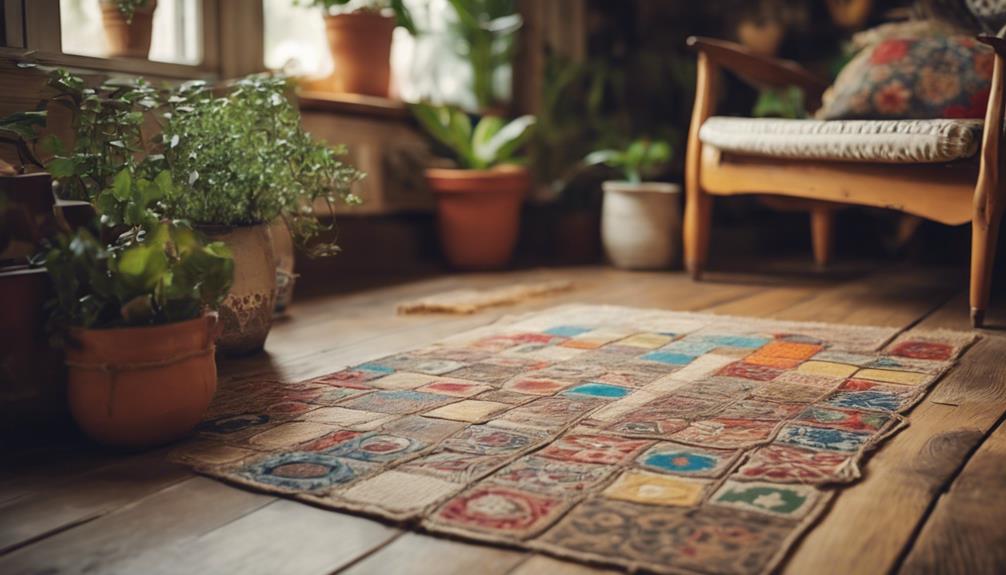
When it comes to flooring in your country home, you've got some charming options to contemplate.
Reclaimed barn wood planks can add a warm, rustic feel, while natural stone tile offers durability and elegance.
If you're looking for a unique touch, a cottage-style painted concrete floor might just be the creative expression your space needs.
Reclaimed Barn Wood Planks
Reclaimed barn wood planks bring unique character and history to your home, making them an ideal choice for rustic flooring. Sourced from old barns, these planks offer not just aesthetic appeal but also a sustainable option for your flooring needs. By repurposing materials that might otherwise end up in a landfill, you're making an environmentally friendly choice that aligns with sustainable building practices.
The rich grain patterns and color variations in reclaimed wood add warmth and charm, creating a cozy atmosphere that complements your country home decor. Plus, many of these planks undergo treatment to eliminate pests and enhance durability, ensuring they can handle daily wear while maintaining their natural beauty.
Installing reclaimed barn wood flooring can also boost your property value. It's often viewed as a high-quality feature by potential buyers who appreciate a rustic aesthetic. So, when you choose reclaimed barn wood, you're not just investing in flooring; you're enhancing the character of your home while making a smart investment.
Embrace the charm and sustainability of reclaimed barn wood planks, and watch your country home transform into a warm, inviting space.
Natural Stone Tile Flooring
Natural stone tile flooring complements the rustic elegance of reclaimed barn wood planks while adding durability and a timeless aesthetic to your country home decor. Each piece of natural stone is unique in color and texture, allowing you to create a personalized and visually appealing foundation for your living spaces. This flooring option not only enhances the charm of your home, but it also provides excellent resistance to wear and tear, ensuring it stands the test of time.
One of the practical benefits of natural stone tiles is their ability to improve indoor air quality. They help reduce allergens and dust accumulation, contributing to a healthier living environment for you and your family. With proper sealing, maintaining your natural stone tile flooring is relatively easy; regular sweeping and occasional mopping will keep it looking its best.
Available in various finishes like honed or polished, natural stone tiles can complement different styles of country decor, from farmhouse elegance to rugged lodge aesthetics. By incorporating natural stone tile flooring into your home, you'll create a beautiful and functional space that embodies the charm of country living.
Cottage-Style Painted Concrete Floor
A cottage-style painted concrete floor adds a charming and personalized touch to your country home, transforming a plain surface into a delightful centerpiece.
To achieve this look, start by cleaning and prepping the concrete, ensuring it's free from dirt and debris for ideal paint adhesion. Using chalk paint is an excellent choice, as it provides a matte finish and great coverage, allowing you to customize colors that complement your decor.
Begin with a primer coat in a neutral shade, then apply multiple coats of your chosen color for durability. This process helps prevent chipping and fading over time.
To enhance the rustic charm, consider using a dry brushing technique with a lighter shade. This creates a distressed effect that mimics aged wood or worn flooring, adding depth to your space.
Conclusion
Incorporating handmade crafts into your country home decor adds warmth and character that store-bought items just can't match.
By focusing on key elements like essential fixtures, unique lighting, and decorative accents, you can create a cozy, inviting space that reflects your personal style.
Don't forget about the flooring—natural materials can enhance the rustic feel.
Embrace your creativity, and let your handmade pieces shine, turning your home into a true expression of who you are.
-

 Vetted2 months ago
Vetted2 months ago14 Best Personalized Father's Day Gifts for Your Husband – Show Him You Care
-

 Alfresco1 month ago
Alfresco1 month agoAlfresco Stacker Doors: Seamless Indoor-Outdoor Living!
-

 Craft and Textiles3 months ago
Craft and Textiles3 months ago15 Best Places to Buy Appliances for Your Home – Top Retailers Reviewed
-

 Decorative Throws3 months ago
Decorative Throws3 months agoIs It Better to Dry Clean Blankets?
-

 Tableware and Dining Accessories3 months ago
Tableware and Dining Accessories3 months agoWhat Is the Meaning of the Word Tableware
-

 Tableware and Dining Accessories3 months ago
Tableware and Dining Accessories3 months agoWhat Is the Hindi Meaning of Tableware
-

 Craft and Textiles3 months ago
Craft and Textiles3 months ago15 Best Cordless Mowers for Effortless Lawn Care – Top Picks of 2024
-

 Yarn3 months ago
Yarn3 months agoIs Yarn Natural or Manmade? Unravel the Truth
























